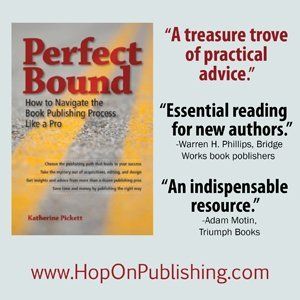The POP Newsletter
Learning from My Clients: Lessons in Publishing Success
In the blog series Publishing Stories, I asked several past clients to share their experiences with publishing.
There are more to come, but I would like to pause here and think about
what we as authors, editors, and publishers can learn from their
stories.
The four profiled authors — Gary Bargatze
, W.K. Dwyer
, Maureen C. Berry
, and Peter C. Diamond
— come from a variety of backgrounds, wrote on wide-ranging topics in
both fiction and nonfiction, and were in varying stages of their careers
as authors.
- Gary Bargatze
, the author of the 8-book historical fiction series titled Your Winding Daybreak Ways
,
chose to hire his own editor and rely on a publishing services company
to produce his book. Starting in 2015, five of the books have been
released with more publishing over the course of 2017.
- W.K. Dwyer
, whose social sci-fi novel The Killing Flower
was just released in fall 2016, arranged all of the vendors —
developmental editor, copyeditor, interior designer, cover artist,
proofreader, printer, and ebook company — himself.
- Maureen C. Berry
left a contract with a publishing house to self-publish her cookbook, Salmon: From Market to Plate
, on her own terms and schedule. The book debuted in 2016.
- Peter Diamond ’s self-help book Amplify Your Career and Life published in 2014. He hired a developmental editor, then contracted with a hybrid publisher for production, distribution, and marketing.
Have a Vision and Stick to It
Gary Bargatze had a vision for his series before he wrote it, and he
followed it through to the end of the project. He was aware of his
abilities, crunched the numbers, and found the path that was economical
for his time and pocketbook.
His use of an editor outside of the publishing services company is one
of the key decisions he made. It saved him money compared to what the
publishing services company offered, and he received what I know to be a
more in-depth edit than most get with a company.
Gary also wasn’t shy. He stood up when the production wasn’t right, and he had his book reviewed in the Baltimore Sun
online ( twice, actually
). He is strategic and pointed with each decision and the success he has had reflects that.
The satisfaction he takes in the journey of publishing is also apparent —
and deeply important to the final judgment of whether this adventure
was a success.
Make a Great Product and Ask for Help When Needed
W.K. Dwyer shared how much he learned over the course of publishing his
first novel, and one lesson is that self-publishing is a whole lot of
work!
There are a lot of moving parts, and it takes a lot of mind space to
keep it all going. He wanted full control over production, especially in
regards to the cover, and that is what he got. His book is beautiful
and well-crafted.
Marketing, as he says, does not happen on its own, and while there is
satisfaction in making a great product, it’s more fun when people buy
the book. Delegating work can help to alleviate the stress.
Indeed, W.K. has since enlisted the help of a marketing expert to get
word out about his book. With that assistance, W.K. is set to meet his
goals.
Be Flexible and Be Determined
Maureen
C. Berry knew what she wanted: a traditional publisher who was going to
support her book idea and her marketing efforts. When she discovered
that wasn’t going to happen, she changed course. She produced the book
on her own to her own standards, and she immersed herself into the
marketing the book.
More than any of the other authors profiled, Maureen has embraced the
work of marketing her book. She has clear determination to give the book
its best shot at selling, and it is selling!
Maureen’s enthusiasm and drive are palpable, and it’s clear that she
enjoys the challenges of marketing. Those two factors go a long way in
whether marketing efforts will pay off. Her traditional publisher would
have done well to keep her.
Revise Expectations and Focus on the Positive
Peter C. Diamond told us that he enjoyed the writing and publishing aspects of making a book.
But like many authors, he underestimated the amount of work involved in
marketing the book. Although he had some help with the marketing, he did
not meet his sales goal.
What I see with Peter, however, is a much bigger success than he may see.
His book is both a self-help book that really does help the people who read it — note the 25 reviews on Amazon
— and a marketing piece for his company. In this situation, there rarely is a one-to-one return on investment.
But for many business people, that’s not the point. Rather, the book
offers intangible benefits in the form of new clients, prestige for the
author, speaking engagements, and other business-related opportunities.
Self-publishing is also very much about the long tail. That is jargon
for the amount of time it takes to make back the investment.
A traditional publisher will market a book for six months and reap as
much profit from that endeavor as possible. That’s the short tail.
Self-publishers have to take a longer view.
More to Come
In the coming months, more authors will share their stories, highlighting other aspects of the publishing life. Some do not see themselves as bearing a lesson, but I assure, there is much more to learn!





